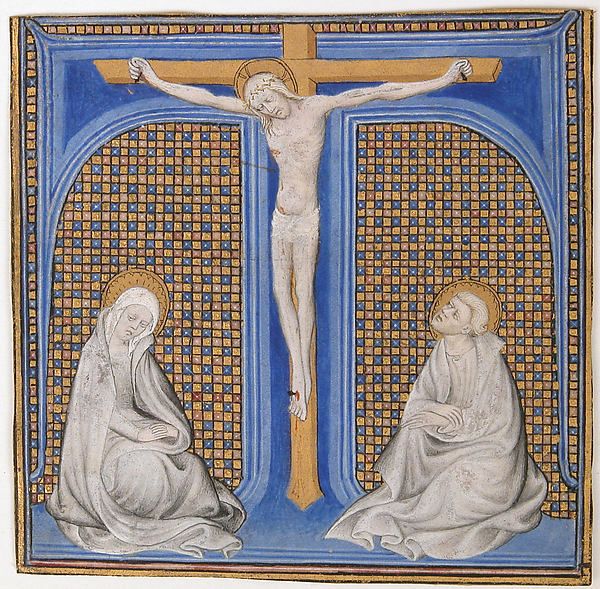Resurrection
Prayer: the usual preparatory prayer. I will beg God our Lord for grace that all my intentions, actions, and operations may be directed purely to the praise and service of His Divine Majesty.
History: The history is how after Christ expired on the Cross, his body remained separated from the soul, but always united with the Divinity. His soul, likewise united with the divinity, descended into hell. There he sets free the souls of the just, then comes to the sepulcher, and rising, appears in body and soul to His Blessed Mother.
Composition of place: Here it will be to see the arrangement of the holy sepulcher and the place or house of our Lady. I will note its different parts, and also her room, her oratory, etc.
Prayer of petition: I will ask for the grace I desire. I will ask the grace to be glad and rejoice intensely because of the great joy and the glory of Christ our Lord.
The four Evangelists record the Resurrection and its principal points, and each one presents its details in his own individual style.
Saint Matthew reports the earthquake, the sight of the angel and the empty tomb. He relates the angel’s words to the holy women to “go quickly and tell” what they have learned; and also Jesus appearance to his apostles in Galilee.
Saint Mark tells us how Mary Magdalene and Mary, the mother of James, standing in the first rays of sunlight, discussed the problem of rolling the stone from its door. He relates their astonishment on discovering the sacred body gone, the message of the angel within the tomb and how they were to tell the news to the Apostles.
Saint Luke describes the appearance to the holy women of two angels, the women’s report to the Eleven, and the Apostle’s incredulity at the story. Saint Luke also tells us how two disciples mistook Jesus for a stranger, and this stranger taught to them the Messianic prophecies and finally how he broke the bread for them and they believed in him.
Saint John presents Peter and John in the tomb examining with awe the folded bandages and shroud, Mary Magdalene looking for Jesus and Christ calling her by her name, Jesus standing among his disciples in the Cenacle, Thomas and his disbelieve, his presence among them in the morning on the shore of the sea of Galilee, and his commission to Peter to feed his sheep.
Faith in the Resurrection has as its object an event which is historically attested to by the disciples, who really encountered the Risen One.
The empty tomb and the linen clothes lying there signify in themselves that by God’s power Christ’s body had escaped the bonds of death and corruption.
They prepared the disciples to encounter the Risen Lord.
Christ, ‘the first-born from the dead’ (Col 1: 18), is the principle of our own resurrection, even now by the justification of our souls (cf. Rom 6: 4), and one day by the new life he will impart to our bodies (cf. Rom 8:11)
We can focus our attention on two moments of this Glorious Christ
Christ appears to the souls of the Just
All who have passed away in God’s grace, the Patriarchs, the Prophets, Joachim, Anne, Zacharias, Elizabeth, Joseph, John the Baptist, all those who were waiting with expectation this day. There, also our first parents Adam and Eve were in silence waiting for their Creator.
An ancient homily relates this moment,
The whole earth keeps silence because the King is asleep.
God has died in the flesh and hell trembles with fear.
He has gone to search for our first parent, as for a lost sheep. With great desire to visit those who live in darkness and in the shadow of death, he has gone to free from sorrow the captives Adam and Eve, he who is both God and the son of Eve. The Lord approached them bearing the cross, the weapon that had won him the victory. At the sight of him Adam, the first man he had created, struck his chest in terror and cried out to everyone: “My Lord be with you all.” Christ answered him: “and with your spirit” He took him by the hand and raised him up, saying: “Awake, O sleeper, and rise from the dead, and Christ will give you light.”
I order you to awake I did not create you to be held a prisoner in hell. Rise from the dead for I am the life of the dead. Rise; let us live this place!
For your sake I, your God, became your son; I, the Lord, took the form of a slave; I, whose home is above the heavens, descended to the earth and beneath the earth. For your sake, for the sake of man, I became like a man without help.
Rise, let us leave the place! The enemy led you out of the earthly paradise. I will not restore you to that paradise, but I will enthrone you in heaven. The banquet is ready. The eternal dwelling places are prepared. The kingdom of heaven has been prepared for you from all eternity.
Christ appears to His Mother
After Jesus had been laid in the tomb, Mary “alone remains to keep alive the flame of faith, preparing to receive the joyful and astonishing announcement of the Resurrection.” (Address at the General Audience, 3 April 1996; L’Osservatore Romano English edition, 10 April 1996, p.7).
The expectation felt on Holy Saturday is one of the highest moments of faith for the Mother of the Lord: in the darkness that envelops the world, she entrusts herself fully to the God of life.
She thinks back to the words of her Son and she hopes in the fulfillment of the divine promises.
The Gospels mention several appearances of the risen Christ, but not a meeting between Jesus and his Mother. This silence cannot lead us to the conclusion that after the Resurrection Christ did not appear to Mary. On the contrary it is an invitation to seek the reasons why the Evangelists made such a choice.
How could Mary not be among those who met the risen Lord?
This silence could be attributed to the fact that what is necessary for our saving knowledge was entrusted to the word of those “chosen by God as witnesses” (Acts 10:41), that is, the Apostles, who gave their testimony of the Lord Jesus’ Resurrection “with great power” (cf. Acts 4:33). Before appearing to them, the Risen One had appeared to several faithful women because of their ecclesial mission: “Go and tell my brethren to go to Galilee, and there they will see me” (Mt 28:10).
The Gospels report a small number of appearances by the risen Jesus and certainly not a complete summary of all that happened during the 40 days after Easter.
St. Paul recalls that he appeared “to more than 500 brethren at one time” (1 Cor 15:6). How do we explain the fact that an exceptional event known to so many is not mentioned by the Evangelists? It is an obvious sign that other appearances of the Risen One were not recorded, although they were among the well-known events that occurred.
How could the Blessed Virgin, present in the first community of disciples (cf. Acts 1:14), be excluded from those who met her divine Son after he had risen from the dead?
Indeed, it is legitimate to think that the Mother was probably the first person to whom the risen Jesus appeared.
Could not Mary’s absence from the group of women who went to the tomb at dawn (cf. Mk 16:1; Mt 28:1) indicate that she had already met Jesus?
And this conclusion can be confirmed thinking that by Jesus’ will, were the women who had remained faithful at the foot of the Cross and therefore were more steadfast in faith.
And the Risen One entrusts to one of them, Mary Magdalene, the message to be passed on to the Apostles (cf. Jn 20:17-18. Perhaps this fact too allows us to think that Jesus showed himself first to his Mother, who had been the most faithful and had kept her faith intact when put to the test.
Also, the unique and special character of the Blessed Virgin’s presence at Calvary and her perfect union with the Son in his suffering on the Cross, are motives that allow us to attribute to her a very particular sharing in the mystery of the Resurrection.
It seems reasonable to think that Mary, had had a personal contact with her risen Son, so that she too could delight in the fullness of paschal joy.
A fifth-century author, Sedulius, maintains that in the splendor of his risen life Christ first showed himself to his mother.
She, who at the Annunciation was the way he entered the world, was called to spread the marvelous news of the Resurrection in order to become the herald of his glorious coming. (cf. Sedulius, Paschale carmen, 5, 357-364, CSEL 10, 140f).
Mother of the Lord is ’cause of joy’ for all people
In the Easter season, the Christian community addresses the Mother of the Lord and invites her to rejoice: “Regina Caeli, laetare. Allelula!”, “Queen of heaven, rejoice. Alleluia!”
It recalls Mary’s joy at Jesus’ Resurrection. We can say that this rejoice comes from the “great joy” that she brought when She gave her “yes” at the Annunciation,
So, we can truly say that she is a cause of “great joy” for all people.
The Resurrection completes the mystery of the Incarnation. He has risen in the flesh because he was born in the flesh (the Word was made flesh). And this body was given to him by her, by Mary.
And so, we turn to Mary after the Resurrection of Christ with the words of Easter joy: “Queen of Heaven, rejoice!”‘

Take, Lord,
and receive all my liberty, my memory, my understanding, and my entire will, all that I have and possess. Thou hast given all to me. To Thee, O Lord, I return it. All is Thine, dispose of it wholly according to Thy will. Give me Thy love and Thy grace, for this is sufficient for me.
(Spiritual Exercises #234. Louis Puhl SJ, Translation.)



